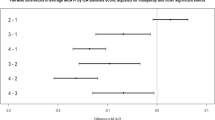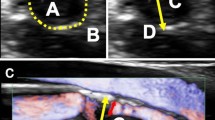Summary
63 subjects with symptomatic obstructive carotid artery disease were investigated with transcranial Doppler ultrasonography. Their blood velocities at rest (V) in the middle and posterior cerebral artery (MCA and PCA) and in the extracranial internal carotid artery were measured and the pulsatility index (PI) and Uhem index (V mca ·PI mca /V pca ·PI pca ) calculated. The vasomotor responses in both MCAs were also tested.
The subjects were divided into groups based on the findings on physical examination and cerebral computed tomography. In the patient group with lacunar/territorial infarction we found in the stroke hemisphere: V mca > V pca , PI mca = PI pca and normal values for the Uhem index and total vasomotor reactivity. In the patient group with watershed infarction this hemisphere was characterized by: V mca < V pca , PI mca < PI pca and subnormal scores for the Uhem index and total vasomotor reactivity. Displaying features from both stroke groups, we obtained in the hemisphere of interest in patients with transient ischaemic attacks: V mca = V pca , PI mca < PI pca and normal values for the Uhem index and total vasomotor reactivity. Five patients with clinical evidence of stroke but with negative cerebral computed tomography findings had scores similar to those of the watershed group of patients.
For the stroke patients, individual measurements of V, PI and total vasomotor reactivity failed to clearly identify to which stroke group a subject might belong. However, such an identification was achieved in all subjects when using the Uhem index. The Uhem index data in patients with transient ischaemic attacks suggest two subgroups with different pathogenesis underlying the ischaemic events.
Similar content being viewed by others
References
Aaslid R (1986) Transcranial Doppier examination techniques. In: Aaslid R (ed) Transcranial Doppler sonography. Springer, Wien New York, pp 39–59
Adams RJ, Nichols FT, Hess DC (1992) Normal values and physiological variables. In: Newell DW, Aaslid R (eds) Transcranial Doppier. Raven, New York, pp 41–48
Gosling RG, King DH (1974) Arterial assessment by Dopplershift ultrasound. Proc R Soc Med 67: 447–449
Harper AM, Glass HI (1965) Effect of alternations in the arterial carbon dioxide tension on the blood flow through the cerebral cortex at normal and low arterial pressures. J Neurol Neurosurg Psychiatry 28: 449–452
Horowitz DR, Tuhrim S, Weinberger JM, Rudolph SH (1992) Mechanisms in lacunar infarction. Stroke 23: 325–327
Kleiser B, Widder B, Hackspacher J, Schmid P (1991) Comparison of Doppier CO2 test, patterns of infarction in CCT, and clinical symptoms in carotid artery occlusions. Neurosurg Rev 14: 267–269
Lindegaard KF, Bakke SJ, Grip A, Nornes H (1984) Pulsed Doppler techniques for measuring instantaneous maximum and mean flow velocities in carotid arteries. Ultrasound Med Biol 10: 419–426
Lindegaard KF, Bakke SJ, Grolimund P, Aaslid R, Huber P, Nornes H (1985) Assessment of intracranial hemodynamics in carotid artery disease by transcranial Doppler ultrasound. J Neurosurg 63: 890–898
Lindegaard KF (1992) Indices of pulsatility. In: Newell DW, Aaslid R (eds) Transcranial Doppler. Raven, New York, pp 67–82
Maeda H, Matsumoto M, Handa N, Hougaku H, Ogawa S, Itoh T, Tsukamoto Y, Kamada T (1993) Reactivity of cerebral blood flow to carbon dioxide in various types of ischemic cerebrovascular disease: evaluation by the transcranial Doppler method. Stroke 24: 670–675
Nornes H (1972) Hemodynamic aspects in the management of carotid-cavernous-fistula. J Neurosurg 37: 687–694
Otis SM, Ringelstein EB (1992) Findings associated with extracranial occlusive disease. In: Newell DW, Aaslid R (eds) Transcranial Doppler. Raven, New York, pp 153–160
Ringelstein EB, Zeumer H, Schneider R (1985) Der Beitrag der zerebralen Computertomographie zur Differentialtypologie und Differantialtherapie des ischaemischen Grosshirninfarktes. Fortschr Neurol Psychiatr 53: 315–354
Ringelstein BE, Sievers C, Ecker S, Schneider PA, Otis SM (1988) Noninvasive assessment of CO2-induced cerebral vaso- motor response in normal individuals and patients with internal carotid artery occlusions. Stroke 19: 963–969
Schomer DF, Marks MP, Steinberg GK, Johnstone IM, Boothroyd DB, Ross MR, Pelc NJ, Enzmann DR (1994) The anatomy of the posterior communicating artery as a risk factor for ischemie cerebral infarction. N Engl J Med 330: 1565–1570
Seibert JJ, Miller SF, Kirby RS, Becton DL, James CA, Glasier CM, Wilson AR, Kinder DL, Berry DH (1993) Cerebrovascular disease in symptomatic and asymptomatic patients with sickle cell anemia: screening with Duplex Transcranial Doppler US-Correlation with MR imaging and MR angiography. Radiology 189: 457–466
Sorteberg A, Sorteberg W, Lindegaard KF, Nornes H (1996) Cerebral hemodynamic considerations in obstructive carotid artery disease. Acta Neurochir (Wien) 138: 68–76
Sorteberg W, Lindegaard KF, Rootwelt K, Dahl A, Russel D, Nyberg-Hansen R, Nornes H (1989) Blood velocity and regional blood flow in defined cerebral artery systems. Acta Neurochir (Wien) 97: 47–52
Sorteberg W, Langmoen IA, Lindegaard KF, Nornes H (1990) Side-to-side differences and day-to-day variations of transcranial Doppler parameters in normal subjects. J Ultrasound Med 9: 403–409
Sundt TM Jr (1987) Occlusive cerebrosvascular disease. Diagnosis and surgical management. Saunders, Philadelphia, pp 243–260
Von Reutern GM, Büdingen HJ (eds) (1989) Ultraschalldiagnostik der hirnversorgenden Arterien. Thieme, Stuttgart, p 39
Vorstrup S, Paulson OB, Lassen NA (1985) How to identify hemodynamic cases. In: Spetzler RF, Carter LP, Selman WR, Martin NA (eds) Cerebral revascularization for stroke. Thieme-Stratton, New York, pp 120–126
Widder B, Paulat K, Hackspacher J, Mayr E (1986) Transcranial Doppler CO2 test for the detection of hemodynamically critical carotid artery stenoses and occlusions. Eur Arch Psychiatr Neurol Sci 236: 162–168
Wodarz R (1980) Watershed infarctions and computed tomography. A topographical study in cases with stenosis or occlusion of the carotid artery. Neuroradiology 19: 245–248
Yonas H, Smith HA, Durham SR, Pentheny SL, Johnson DW (1993) Increased stroke risk predicted by compromised cerebral blood flow reactivity. J Neurosurg 79: 483–489
Zülch KJ (1961) Die Pathogenese von Massenblutungen und Erweichung unter besonderer Berücksichtigung klinischer Gesichtspunkte. Acta Neurochir (Wien) [Suppl] 7: 51–117
Author information
Authors and Affiliations
Rights and permissions
About this article
Cite this article
Sorteberg, A., Sorteberg, W., Lindegaard, K.F. et al. Haemodynamic classification of symptomatic obstructive carotid artery disease. Acta neurochir 138, 1079–1087 (1996). https://doi.org/10.1007/BF01412311
Issue Date:
DOI: https://doi.org/10.1007/BF01412311




